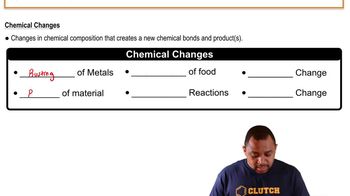Here are the essential concepts you must grasp in order to answer the question correctly.
Physical Change
A physical change involves a transformation that does not alter the chemical composition of a substance. Examples include changes in state, shape, or size, such as breaking, dissolving, or melting. In the case of aspirin tablets being broken in half, the tablets remain chemically the same; only their physical form is altered.
Recommended video:
Physical and Chemical Changes
Chemical Change
A chemical change results in the formation of one or more new substances with different chemical properties. This process often involves a chemical reaction, where bonds between atoms are broken and formed. Unlike physical changes, chemical changes are usually irreversible under normal conditions, such as burning or rusting.
Recommended video:
Physical & Chemical Changes
Distinguishing Changes
To distinguish between physical and chemical changes, one must consider whether the substance's identity is altered. If the change can be reversed and the original substance can be recovered, it is likely a physical change. Conversely, if the change results in new substances that cannot be reverted to the original form, it is a chemical change.
Recommended video:
Physical & Chemical Changes
 Verified step by step guidance
Verified step by step guidance Verified Solution
Verified Solution



 1:41m
1:41m